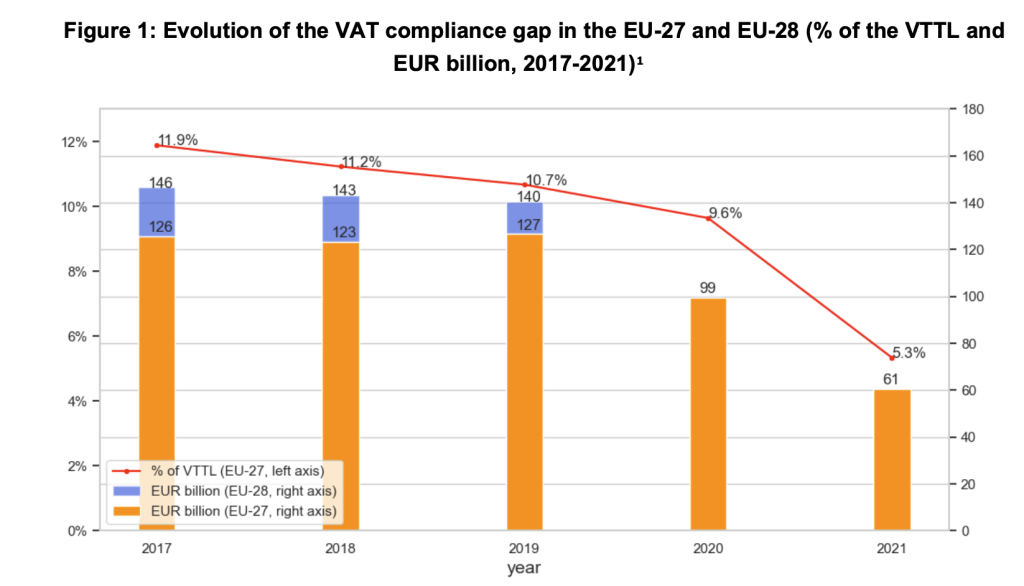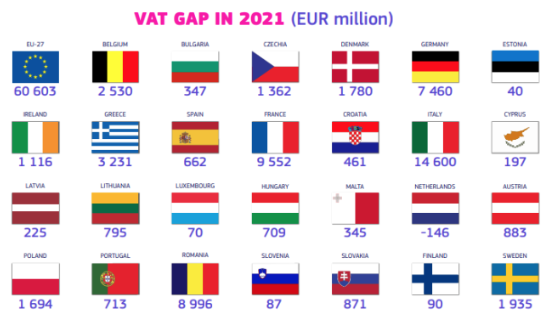2022 latest estimate of lost EU VAT widening by €13bn with mixed results across EU 27
On 18 December 2024, the latest estimate of missing VAT revenues across the EU 27 member states was published by the European Commission. This shows an increase in the levels of uncollected VAT from €76bn in 2021 to €89bn.
The major contribution to this rise is the effects of COVID and energy inflation hike following the invasion of Ukraine by Russia. Bankruptcies were up 21% in 2022 following the ending of the pandemic support and then sharp rise in prices and dampening effect on economic activity. This was partially offset by increased use of online e-commerce, with its electronic payment records promoting full tax reporting compared to cash.
The benefits of continuing digitalisation has offset the negative pressures above, with tax authorites’ policy measures helping to limit lost revenues.
The trend however remains down: €121bn back in 2018.
Countries with major improvements since 2021 include: Belgium; Denmark; and Slovenia. But there were significant reverses in: Latvia; Cyprus; Lithuania; and Romania.
|
|
VAT fraud and MTIC analysis: A specific analysis of Missing Trader Intra-Community (MTIC) fraud shows annual losses of EUR 13-33 billion between 2010 and 2023 due to the exploitation of VAT-free cross-border trade.
|
|
|
Digitalization efforts: Targeted measures such as e-invoicing, real-time transaction reporting and the digitalisation of the tax system have played a key role in reducing the VAT gap.
|
|
|
VAT policy gap: Exemptions and reduced rates contributed significantly to uncollected revenue, suggesting potential for further reforms.
|
2021 to 2022 VAT compliance gap analysis
COVID and inflation-linked bankruptcies; sector hits
The rise in the gap has been attributed to financial difficulties following the ending of the COVID pandemic. In particular, the tourism and hospitality sectors were most damaged.
2021 estimate of lost EU VAT shows €38bn improvement largely due improved measures
Most EU Member States made progress in the enforcement of Value-Added Tax (VAT) compliance in 2021, according to the new 2023 VAT Gap report released by the European Commission today. The annual study shows that Member States lost around €61 billion in VAT in 2021, compared to €99 billion in 2020.
The biggest cuts were in: Italy, Cyprus, Poland, Belgium and Ireland. Only Denmark and Sweden showed a slight worsening in their gaps. Much of the reduction may be down to ongoing COVID effects. Positive changes in compliance might have been caused by COVID support measures contingent on paying taxes and reducing the frequency of bankruptcies. But new anti-fraud and simpler compliance measures are also responsible.
The % of VAT lost is now standing at 5.3% of expected revenues, down from 9.6% in the previous year. It has shown sharp falls over 10 years from its peak 2013. Many of the Eastern European countries have made major strides in bringing their shortfalls down. Strikingly, Romania has shown limited improvement in its high gap. It is one of the few countries in the east not to have fully adopted transactional reporting – but SAF-T reporting and RO e-Factura are now being rolled out.
Italy alone accounts for 24% of the EU’s VAT Gap, but this is down from the higher levels just a few years ago. Italy has already stated that it believes the next numbers, covering 2022, will show a further substantial cut.

In 2020 European Union member states had estimated a loss €93bn billion per annum in Value Added Tax revenues based on the European Commission’s (EC) ‘VAT Gap’ estimate. This was 9.6% of VAT revenues. The comparable 2019 VAT Gap was €124 billion (excluding the UK).

The VAT Gap seeks to estimate the difference between tax forecasts and actual receipts. Losses are down to:
- liquidations of companies owing VAT;
- tax authorities administrative inefficiencies
- lawful VAT structure optimisation; and
- fraud.
The European Commission Taxud launched a EU VAT Gap Initiative in 2022 to help exchange ideas between EU member states’ tax administrations to help close the gap.
ViDA proposals on e-invoicing and digital reporting to close gap further
The EU proposals for VAT in the Digital Age, which will include intra-community digital reporting requirements and e-invoicing to help drive down this gap further.





